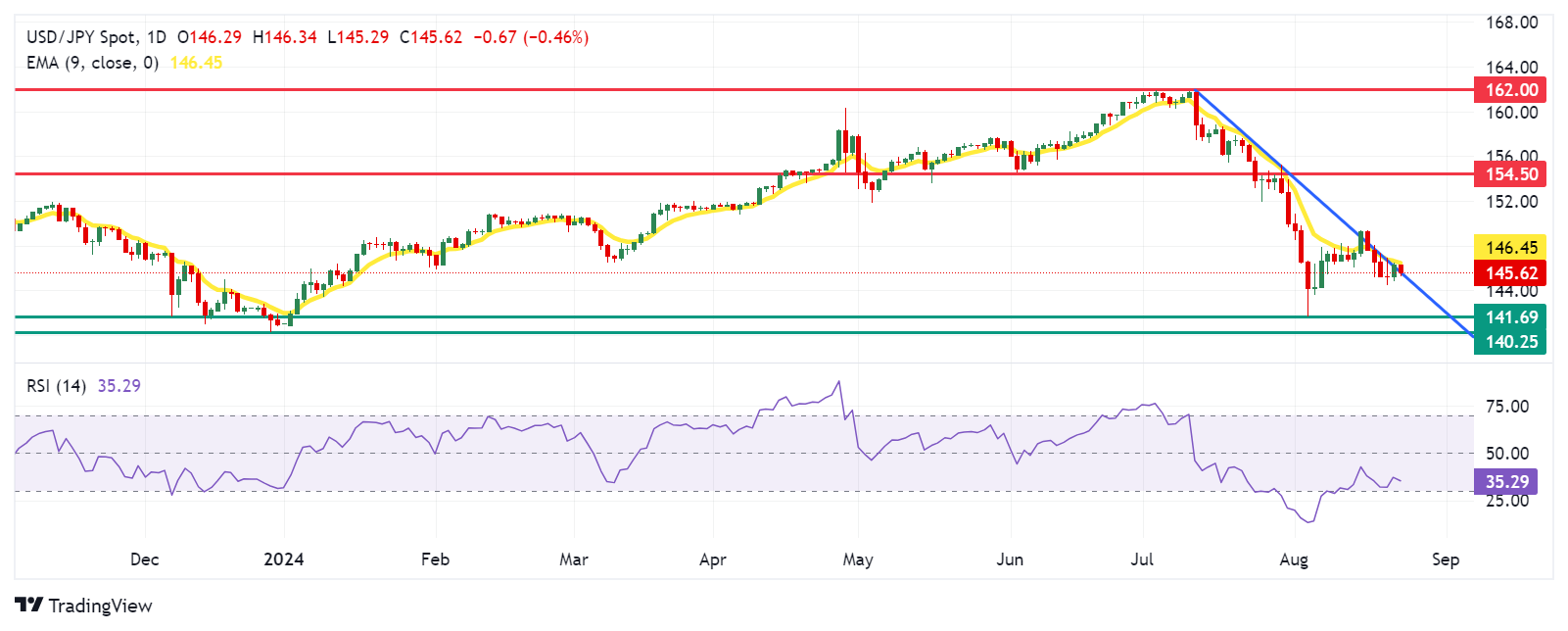- The Japanese Yen is appreciating after the speech of BoJ Governor Kazuo Ueda.
- Japan’s national CPI rose 2.8% year-on-year in July, holding at its highest level since February.
- Fed Chair Powell could make a statement on the possibility of rate cuts at the Jackson Hole symposium.
The Japanese Yen (JPY) strengthened against the US Dollar (USD) following the release of the National Consumer Price Index (CPI) inflation data and a speech by Bank of Japan (BoJ) Governor Kazuo Ueda in Parliament on Friday. Ueda stated that “the BoJ raised rates in July as the economy and inflation moved largely in line with forecasts.”
BoJ Governor Ueda also indicated that there would be no change in the stance on tightening monetary easing if the economy and inflation continue to align with forecasts. Ueda noted that the BoJ’s recent policy decisions have been appropriate and warned that outlining the path of future policy could lead to unnecessary speculation.
The USD/JPY pair is depreciating as the US Dollar comes under downward pressure from lower Treasury yields. However, the Dollar gained ground following mixed S&P Global Purchasing Managers Index (PMI) data released on Thursday.
In addition, US Federal Reserve (Fed) Chairman Jerome Powell will speak at the Jackson Hole Symposium later on Friday. Powell is expected to make a statement on the possibility of interest rate cuts in the United States (US), which is highly anticipated by market participants.
Daily Market Wrap: Japanese Yen Advances After BoJ Governor Ueda’s Speech
- Japan’s National Consumer Price Index rose 2.8% year-on-year in July, holding steady for the third consecutive month and remaining at its highest level since February. In addition, the National CPI excluding fresh food rose 2.7%, the highest reading since February, in line with expectations.
- The US Composite PMI fell to 54.1 in August, a four-month low, from 54.3 in July, but remained above market expectations of 53.5. This indicates continued expansion in US business activity, marking 19 consecutive months of growth.
- The S&P Global US Services PMI rose to 55.2 in August 2024 from 55.0 in July, defying expectations for a drop to 54.0. Meanwhile, the Manufacturing PMI declined to 48.0 in August from 49.6 the previous month, missing market expectations of 49.6 and signalling the second consecutive contraction in US manufacturing activity at the sharpest rate this year.
- On Thursday, Federal Reserve Bank of Boston President Susan Collins expressed confidence that the U.S. central bank can reduce inflation without causing a recession and indicated support for beginning interest rate cuts next month. In an interview with Reuters in Jackson Hole, Collins said: “I think there is a clear path to achieving our goals without an unnecessary slowdown, and with a labor market that remains healthy.”
- Kansas City Fed President Jeff Schmid said in an interview with CNBC in Jackson Hole that he is closely examining the factors behind the rising unemployment rate and will rely on the data to determine whether he supports a rate cut next month.
- The FOMC minutes from its July policy meeting indicated that most Fed officials agreed last month that they would likely cut their benchmark interest rate at the next meeting in September as long as inflation continued to cool.
- Japan’s merchandise trade balance fell to a deficit of ¥621.84 billion in July, reversing the ¥224.0 billion surplus reported in June and missing market estimates of a ¥330.7 billion deficit. Japan’s imports rose 16.6% year-on-year in July, hitting a 19-month high of ¥10,241.01 billion, significantly above the 3.2% increase in June. Meanwhile, exports rose 10.3% year-on-year to a seven-month high of ¥9,619.17 billion, missing market forecasts of 11.4%.
Technical Analysis: USD/JPY drops towards 145.50 around the downtrend line
USD/JPY is trading around 145.60 on Friday. The daily chart analysis shows that the pair is positioned above a downtrend line, suggesting a weakening of the bearish bias. However, the 14-day Relative Strength Index (RSI) remains just above 30, indicating that the downtrend could still be in play.
As for the support levels, the USD/JPY pair is testing the downtrend line at the level of 145.50. A break below this level could reinforce the bearish bias and push the pair to navigate the region around the seven-month low of 141.69, recorded on August 5. A further decline could lead the pair towards the retracement support level at 140.25.
On the upside, the USD/JPY pair could find immediate resistance around the nine-day exponential moving average (EMA) at the level of 146.46. A break above the nine-day EMA could support the pair to test the resistance level at 154.50, which has turned from previous support to current resistance.
USD/JPY: Daily Chart
Japanese Yen PRICE Today
The table below shows the Japanese Yen (JPY) exchange rate against major currencies today. The Japanese Yen was the strongest currency against the US Dollar.
| USD | EUR | GBP | JPY | CAD | AUD | NZD | CHF | |
|---|---|---|---|---|---|---|---|---|
| USD | -0.14% | -0.12% | -0.47% | -0.15% | -0.23% | -0.45% | 0.14% | |
| EUR | 0.14% | 0.02% | -0.31% | 0.00% | -0.09% | -0.07% | 0.28% | |
| GBP | 0.12% | -0.02% | -0.34% | -0.04% | -0.11% | -0.07% | 0.02% | |
| JPY | 0.47% | 0.31% | 0.34% | 0.31% | 0.24% | 0.24% | 0.38% | |
| CAD | 0.15% | -0.01% | 0.04% | -0.31% | -0.08% | -0.05% | 0.06% | |
| AUD | 0.23% | 0.09% | 0.11% | -0.24% | 0.08% | 0.03% | 0.12% | |
| NZD | 0.45% | 0.07% | 0.07% | -0.24% | 0.05% | -0.03% | 0.10% | |
| CHF | -0.14% | -0.28% | -0.02% | -0.38% | -0.06% | -0.12% | -0.10% |
The heatmap shows percentage changes of major currencies. The base currency is selected from the left column, while the quote currency is selected from the top row. For example, if you choose the Japanese Yen from the left column and move along the horizontal line to the US Dollar, the percentage change shown in the chart will represent the JPY (base)/USD (quote).
Japanese Yen FAQs
The Japanese Yen (JPY) is one of the most traded currencies in the world. Its value is determined broadly by the performance of the Japanese economy, but more specifically by the policy of the Bank of Japan, the spread between Japanese and US bond yields, and risk sentiment among traders, among other factors.
One of the Bank of Japan’s mandates is currency control, so its moves are key to the Yen. The BoJ has intervened directly in currency markets on occasion, usually to lower the value of the Yen, although it often refrains from doing so due to political concerns of its major trading partners. The BoJ’s current ultra-loose monetary policy, based on massive stimulus to the economy, has caused the Yen to depreciate against its major currency peers. This process has been exacerbated more recently by a growing policy divergence between the BoJ and other major central banks, which have opted to sharply raise interest rates to combat decades-old levels of inflation.
The Bank of Japan’s stance of maintaining an ultra-loose monetary policy has led to an increase in policy divergence with other central banks, in particular with the US Federal Reserve. This favours the widening of the spread between US and Japanese 10-year bonds, which favours the Dollar against the Yen.
The Japanese Yen is often considered a safe haven investment. This means that in times of market stress, investors are more likely to put their money into the Japanese currency due to its perceived reliability and stability. In turbulent times, the Yen is likely to appreciate against other currencies that are considered riskier to invest in.
Source: Fx Street
I am Joshua Winder, a senior-level journalist and editor at World Stock Market. I specialize in covering news related to the stock market and economic trends. With more than 8 years of experience in this field, I have become an expert in financial reporting.








